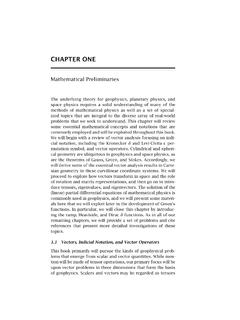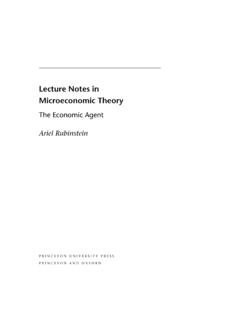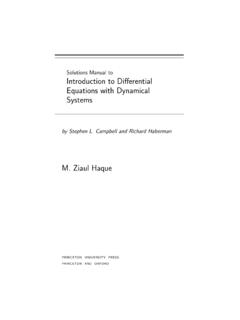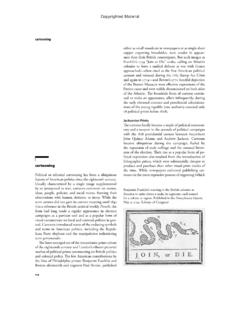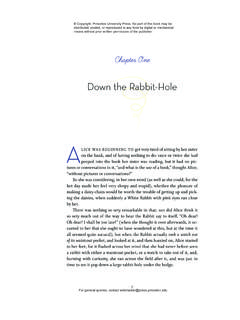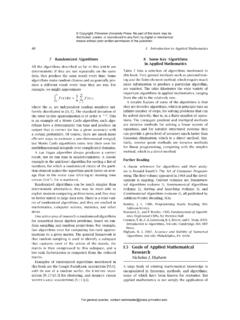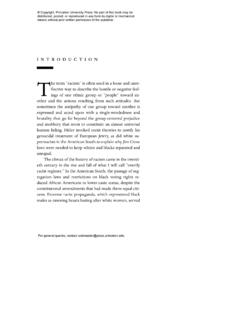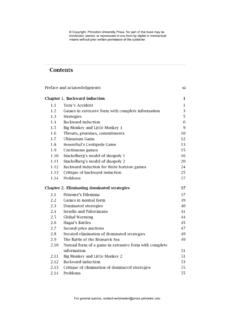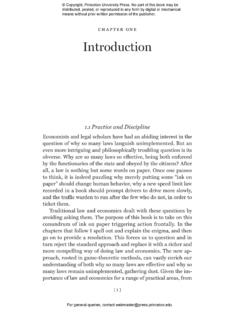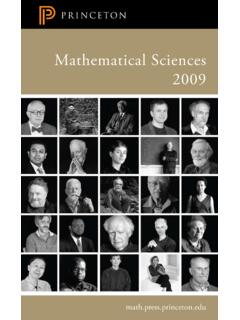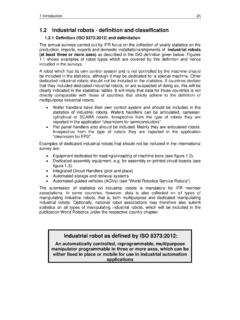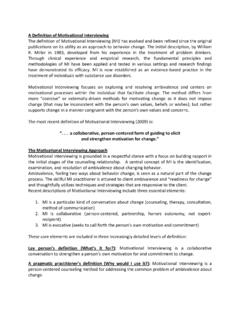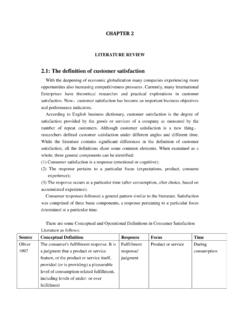Transcription of 1. DEFINITION OF LEGAL INTERPRETATION
1 CHAPTER ONEWhat Is LEGAL INTERPRETATION ?1. DEFINITION OF LEGAL INTERPRETATIONOn the Concept of INTERPRETATION in Law INTERPRETATION in law has different , the word inter - pretation itself must be define LEGAL INTERPRETATION as fol-lows: LEGAL INTERPRETATION is a rational activity that gives meaning to a requirement of rationality is key a coin toss is not interpretiveactivity. INTERPRETATION is an intellectual activity,4concerned with deter-mining the normative message that arises from the the text isand whether it is valid are questions related to INTERPRETATION , but they aredistinct from it. I assume the existence of a valid LEGAL text. The questionis what meaning to attach to that text. According to my DEFINITION , then, INTERPRETATION shapes the content of the norm trapped inside the text that is the object of INTERPRETATION may be general (as in a consti-tution, statute, case law, or custom) or individual (as in a contract or will).
2 It may be written (as in a written constitution or judicial opinion) or oral(as in an oral will or a contract implied-in-fact). The word text is not lim-ited to a written text. For purposes of INTERPRETATION , any behavior that cre-ates a LEGAL norm is a text. 1 SeeA. Barak, Parshanut B mishpat[ INTERPRETATION in Law] 29 (1992) and citationstherein. See alsoW. Twinning and D. Miers, How to Do Things with Rules166 (4th ed. 1999);G. Gottlieb, The Logic of Choice95 (1968); A. Barnes, On Interpretation7 (1988); A. Mar-mor, INTERPRETATION and LEGAL Theory13 (1992); A. Marmor, Positive Law and Objective Val-ues71 (2001). Moore, LEGAL INTERPRETATION , 18 Iyunei Mishpat359 (1994), and , Language and Law, 61 Law Q. Rev. 71, 392 (1945).3 SeeC. Ogden and I. Richards, The Meaning of Meaning(10th ed. 1956); Moore, The Semantics of Judging, 54 S.
3 Cal. L. Rev. 151 (1981); R. Cross, Statutory Interpreta-tion(J. Bell and G. Engle eds., 3d ed. 1995); H. Hart and A. Sachs, The LEGAL Process: BasicProblems in the Making and Application of Law1374 (W. Eskridge and P. Frickey eds., 1994);A. Dickerson, The INTERPRETATION and Application of Statutes34 (1975).4 SeeH. Kelsen, Pure Theory of Law 348 (Knight trans. from German, 2d ed. 1967).5 See K. Larenz, Methodenlehre der Rechtswissenschaft(5th ed. 1983); R. Zippelius, Ein-f hrung in die Juristische Methodenlehre(1971). Copyright, Princeton University Press. No part of this book may be distributed, posted, or reproduced in any form by digital or mechanical means without prior written permission of the publisher. For general queries, contact Definitions of LEGAL InterpretationThe DEFINITION of LEGAL INTERPRETATION at the core of this book is not the onlypossible DEFINITION .
4 Some theorists define INTERPRETATION more narrowly,others, more broadly. Under a narrower or constrictive DEFINITION , there isroom for INTERPRETATION only in places where the text is unclear, such thatthere are differences of opinion over , a constrictive definitionmight restrict LEGAL INTERPRETATION to finding the meaning that realizes theintent of the LEGAL text s do not adopt these definitions. Accord-ing to my theory, every LEGAL text requires INTERPRETATION . The plainness ofa text does not obviate the need for INTERPRETATION , because such plainnessis itself a result of INTERPRETATION . Even a text whose meaning is undisputedrequires INTERPRETATION , for the absence of dispute is a product of interpre-tation. Realizing the intent of the author is the goal of one kind of systemof INTERPRETATION (subjective interpretation8).
5 INTERPRETATION , however, canalso give the LEGAL text a meaning that actualizes objective standards (ob-jective interpretation9). The DEFINITION of INTERPRETATION (in contrast to sys-tems of INTERPRETATION within that DEFINITION ) cannot be reduced to merelygiving meaning that realizes authorial Definitions of LEGAL InterpretationLegal INTERPRETATION may also be conceptualized more expansively than mydefinition permits. For example, Dworkin defines law itself as an interpre-tive process: LEGAL practice is an exercise in INTERPRETATION not just when lawyers interpretdocuments or statutes but also generally. Propositions of law are not simplydescriptive of LEGAL history, in a straightforward way, nor are they simply eval-uative in some way divorced from LEGAL history. They are interpretive of legalhistory, which combines elements of both description and evaluation, but isdifferent from Dworkin s approach has been the subject of criticism,11an evalua-tion of his DEFINITION and the critique of it are beyond the scope of this4 CHAPTER ONE6 See J.
6 Wr blewski, The Judicial Application of Law 88 (1992). Hawkins, On the Principles of LEGAL INTERPRETATION , 2 Jurid. Soc y Papers298,307 (1860).8 Seep. 32, 33, Dworkin, Law as INTERPRETATION , 60 Tex. L. (1982). Moore, The Interpretive Turn in Modern Theory: A Turn for the Worse? 41 Stan. L. (1989); D. Patterson, The Poverty of Interpretive Universalism: To- Copyright, Princeton University Press. No part of this book may be distributed, posted, or reproduced in any form by digital or mechanical means without prior written permission of the publisher. For general queries, contact Dworkin s DEFINITION lies at the foundation of his philosophic proj-ect, and I respect it. My DEFINITION , however, is narrower. It lies at the foun-dation of a different project, whose concern is giving meaning to a legaltext.
7 The two projects are distinct but interrelated. From Dworkin s defi-nition of INTERPRETATION , one can derive a system of understanding a legaltext such as a constitution or statute. In that sense, Dworkin s (expansive)theory of INTERPRETATION becomes one of a variety of systems of interpreta-tion (as defined above).The Limits of INTERPRETATION in LawMy DEFINITION of INTERPRETATION raises a number of questions of classifica-tion. The answers to these questions determine if the standards for inter -preting a text can apply to additional LEGAL activities. First, does resolving(antinomic) contradictions in a given LEGAL text constitute interpretive ac-tivity? In my view, the answer to that question is yes. Imparting meaningto a given text requires resolving internal contradictions within the text it-self. Second, does resolving contradiction between different LEGAL texts onthe same normative plane (two statutes, two contracts, two wills), or ondifferent normative planes (constitution and statute, statute and contract,contract and will), constitute interpretive activity?
8 Of course, giving mean-ing to eachof those texts constitutes interpretive activity, but does resolv-ing the contradiction based on the meaning given constitute an inher-ently interpretive activity? The question has no clear answer, other thansaying that it depends on the tradition of a given LEGAL system. In my view,however and depending on the particularities of the LEGAL traditions inquestion resolving contradiction between norms arising from differenttexts is a non-interpretive activity. True, in resolving contradictions be-tween different texts, we give meaning to a LEGAL system. But this giving ofmeaning constitutes interpretive activity only in Dworkin s broad sense. Itdoes not constitute INTERPRETATION in the sense I give to the word. For ex-ample, the rule of constitutional supremacy that a statute which violatesa constitutional provision is invalid is a rule that resolves contradictions,but it is not a rule of INTERPRETATION .
9 Third, does filling in a lacuna or gapin a LEGAL text constitute interpretive activity? The German LEGAL traditiondistinguishes between ordinary INTERPRETATION (einfache Auslegung) andsupplementary INTERPRETATION (erg nzende Auslegung). Indeed, the answerto this (third) question also depends on the LEGAL tradition in question. Ipersonally distinguish between INTERPRETATION in the narrow sense the in-WHAT IS LEGAL INTERPRETATION ?5ward the Reconstruction of LEGAL Theory , 72 Tex. L. (1993). See 3798/94 Anonymous v. Anonymous, 50(3) 133, 174. Copyright, Princeton University Press. No part of this book may be distributed, posted, or reproduced in any form by digital or mechanical means without prior written permission of the publisher. For general queries, contact that gives meaning to a LEGAL text and INTERPRETATION in thebroad sense, which includes filling gaps in an incomplete text.
10 The justifi-cation in calling the second activity interpretive if only in the broadsense stems from the fact that it does ultimately give meaning to a text,determining the normative message arising from it. Referring to the addi-tion of an implied term to a contract, Hoffman writes: It may seem oddto speak of INTERPRETATION when, by DEFINITION , the term has not been ex-pressed in words, but the only difference is that when we imply a term, weare engaged in interpreting the meaning of the contract as a whole. 12 Forthis reason, I include correcting the language of the text, as in fixing a mis-take, as part of INTERPRETATION in the broad do I insist on distinguishing between INTERPRETATION in its broad andnarrow sense? The standards governing these two activities are separate and distinct systems govern the INTERPRETATION of an existingtext and the completion of an incomplete text.
